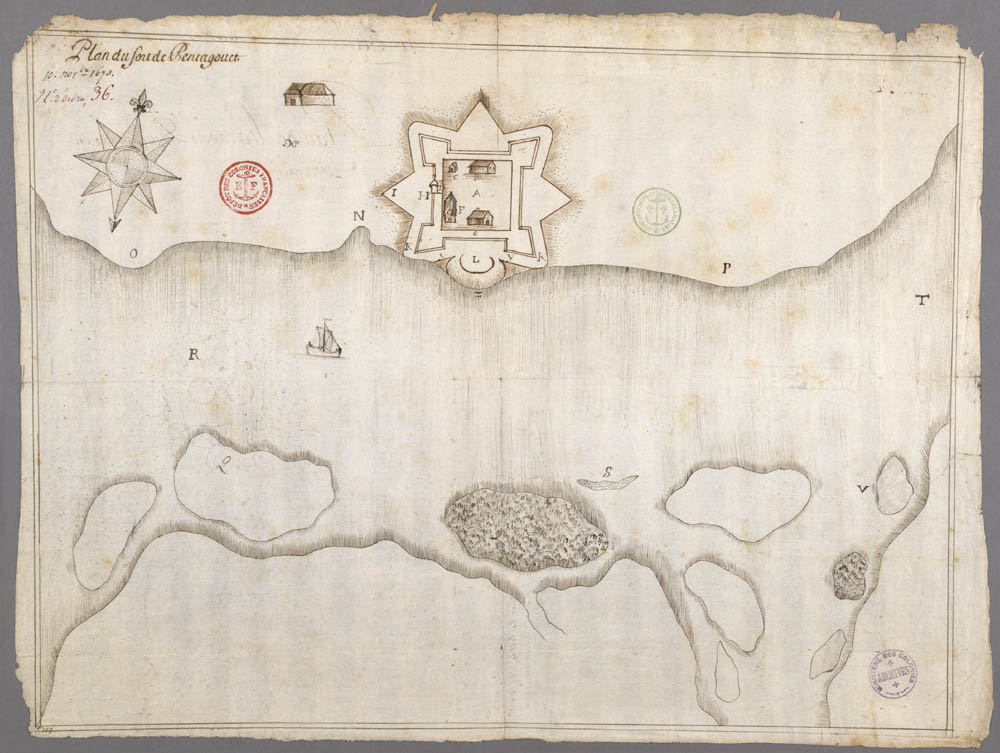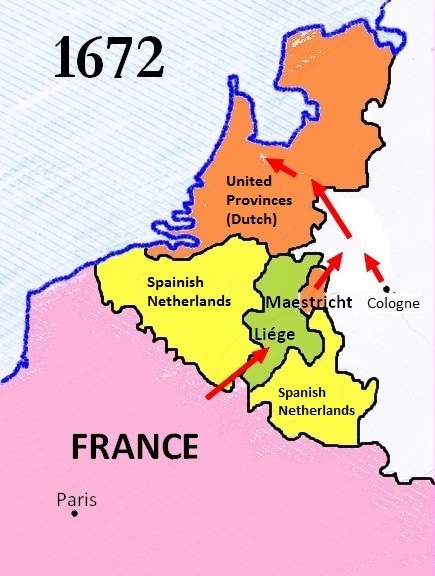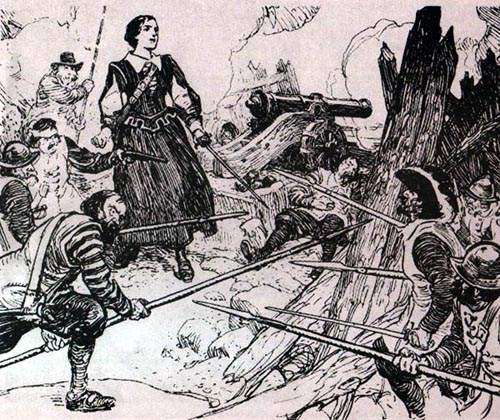|
Fort Pentagoet
Fort Pentagouët (Fort Pentagoet, Fort Castine, Fort Penobscot, Fort Saint-Pierre) was a French fort established in present-day Castine, Maine, which was the capital of Acadia (1670–1674). It is the oldest permanent settlement in New England. Its commanding position at the mouth of the Penobscot River estuary, a lucrative source of furs and timber, as well as a major transportation route into the interior, made the peninsula of particular interest to European powers in the 17th century. Majabagaduce (as the Abenaki name would be corrupted) changed hands numerous times with shifting imperial politics. At one time or another, it was occupied by the French, Dutch and England's Plymouth Colony. La Tour Castine was founded in the winter of 1613, when Claude de Saint-Étienne de la Tour established a small trading post to conduct business with the Tarrantine Indians. After the trading post was established at Castine, a raid by English captain Samuel Argall at Mount Desert Island i ... [...More Info...] [...Related Items...] OR: [Wikipedia] [Google] [Baidu] |
Fort De Pentagouet En 1670
A fortification (also called a fort, fortress, fastness, or stronghold) is a military construction designed for the defense of territories in warfare, and is used to establish rule in a region during peacetime. The term is derived from Latin ("strong") and ("to make"). From very early history to modern times, defensive walls have often been necessary for cities to survive in an ever-changing world of invasion and conquest. Some settlements in the Indus Valley Civilization were the first small cities to be fortified. In ancient Greece, large cyclopean stone walls fitted without mortar had been built in Mycenaean Greece, such as the ancient site of Mycenae. A Greek ''Towns of ancient Greece#Military settlements, phrourion'' was a fortified collection of buildings used as a military garrison, and is the equivalent of the ancient Roman, Roman castellum or fortress. These constructions mainly served the purpose of a watch tower, to guard certain roads, passes, and borders. Th ... [...More Info...] [...Related Items...] OR: [Wikipedia] [Google] [Baidu] |
Mount Desert Island
Mount Desert Island (MDI; ) in Hancock County, Maine, is the largest island off the coast of Maine. With an area of it is the List of islands of the United States by area, 52nd-largest island in the United States, the sixth-largest island in the contiguous United States, and the second-largest island on the East Coast of the United States, Eastern Seaboard, behind Long Island and ahead of Martha's Vineyard. According to the 2010 census, the island has a year-round population of 10,615. In 2017, an estimated 3.5 million tourists visited Acadia National Park on MDI. The island is home to numerous well-known summer colony, summer colonies such as Northeast Harbor, Maine, Northeast Harbor and Bar Harbor, Maine, Bar Harbor. Origin of the name Some residents stress the second syllable ( ), while others pronounce it like the English common noun ''desert'' ( ). French explorer Samuel de Champlain's observation that the summits of the island's mountains were free of vegetation as seen fr ... [...More Info...] [...Related Items...] OR: [Wikipedia] [Google] [Baidu] |
Franco-Dutch War
The Franco-Dutch War, 1672 to 1678, was primarily fought by Kingdom of France, France and the Dutch Republic, with both sides backed at different times by a variety of allies. Related conflicts include the 1672 to 1674 Third Anglo-Dutch War and 1675 to 1679 Scanian War. In May 1672, France nearly overran the Netherlands, an event remembered in Dutch history as the ''Rampjaar'', or "Disaster Year". However, by late July the position had stabilised, while concern over French gains brought the Dutch support from Leopold I, Holy Roman Emperor, Emperor Leopold I, Habsburg Spain, Spain and Brandenburg-Prussia. Previously an ally of France, Kingdom of England, England Treaty of Westminster (1674), exited the war in February 1674. Now facing a war of attrition on several fronts, Louis XIV of France instead focused on strengthening French borders with the Spanish Netherlands and Rhineland, while a coalition led by William III of England, William of Orange sought to minimise any losses. ... [...More Info...] [...Related Items...] OR: [Wikipedia] [Google] [Baidu] |
Castine Hist
Castine may refer to: *Castine, Maine Castine ( ) is a town in Hancock County in eastern Maine, United States.; John Faragher. ''Great and Nobel Scheme''. 2005. p. 68. The population was 1,320 at the 2020 census. Castine is the home of Maine Maritime Academy, a four-year institut ..., U.S. ** Castine (CDP), Maine, the main village in the town * Castine, Ohio, U.S. * USS ''Castine'', two ships in the United States Navy See also * {{disambiguation, geo ... [...More Info...] [...Related Items...] OR: [Wikipedia] [Google] [Baidu] |
Carignan-Salières Regiment
The Carignan-Salières Regiment was a 17th-century French military unit formed by the merging of two other regiments in 1659. Approximately 1,100 men from the regiment were sent to New France in 1665 to deal with the threat of the Iroquois to the colony. While in New France they were under the command of the Lieutenant Général of the Americas, Alexandre de Prouville de Tracy; the Governor General of New France, Governor General, Daniel de Rémy de Courcelle; and their colonel, Henri de Chastelard de Salières. The regiment constructed fortifications along the Richelieu River, and took part in three expeditions against the Iroquois in 1666. A peace settlement was reached the following year. Roughly 400 officers and soldiers remained behind in New France as settlers when the regiment returned to France in 1668. Early history The Carignan-Salières Regiment was the result of the merger of the Carignan Regiment with the Salières Regiment in 1659. The Carignan Regiment was raised in ... [...More Info...] [...Related Items...] OR: [Wikipedia] [Google] [Baidu] |
Jacques De Chambly
Jacques de Chambly (born 1612, died 1687) was from a French military background and became a seigneur in the New World and a governor of Acadia. Chambly arrived in New France in 1665 when he was a captain in the Carignan-Salières Regiment. He immediately was in charge of the construction of Fort Saint-Louis (now known as Fort Chambly) on the Richelieu Rapids. He then took part in the Prouville de Tracy’s expedition against the Iroquois. When his regiment was disbanded he returned to France but returned to service in Canada in 1670. In 1672 he received a seigneury on the Richelieu River in present-day Quebec, Canada. In 1673 he was appointed governor of Acadia, replacing Hector d'Andigné de Grandfontaine at the capital of Acadia, Fort Pentagouet. Chambly died in Martinique Martinique ( ; or ; Kalinago language, Kalinago: or ) is an island in the Lesser Antilles of the West Indies, in the eastern Caribbean Sea. It was previously known as Iguanacaera which transla ... [...More Info...] [...Related Items...] OR: [Wikipedia] [Google] [Baidu] |
Hector D'Andigné De Grandfontaine
Hector d'Andigné de Grandfontaine (baptized 17 May 1627; died 6 July 1696) was a French naval officer who served as the governor of Acadia from 1670 to 1673. Grandfontaine was baptised in France and became a Knight of Malta. He was captain of a company in Quebec in 1665 and participated in a military campaign against the Mohawk people. He was appointed governor of Acadia in 1670 after the region was returned to French governance by the British. He tried to bolster French control of the region by resolving the concerns of the citizens of the colony and encouraging French loyalty. Upon his return to France he was appointed as a naval officer. He received the Order of Saint Louis and died on 6 July 1696. Early life and family Grandfontaine was baptised in Ruillé-Froid-Fonds. His father was named Hector and his mother was named Anne. His grandfather, Gaston d’Andigné, received the Grandfontaine property and it was added to the family name. Hector was the youngest of four boy ... [...More Info...] [...Related Items...] OR: [Wikipedia] [Google] [Baidu] |
Port-Royal (Acadia)
Port Royal (1605–1713) was a historic settlement based around the upper Annapolis Basin in Nova Scotia, Canada, and the predecessor of the modern town of Annapolis Royal. It was the first successful attempt by Europeans to establish a permanent settlement in what is today known as Canada. Port Royal was a key step in the development of New France and was the first permanent base of operations of the explorer Samuel de Champlain, who would later found Quebec City, Quebec in 1608, and the farmer Louis Hébert, who would resettle at Quebec in 1617. For most of its existence, it was the capital of the New France colony of Acadia. Over 108 years control would pass between France, Scotland, England and Great Britain until it was formally ceded to Great Britain in 1713 due to the Treaty of Utrecht. From 1605 to 1613 the settlement was centred around the habitation on the north side of the Annapolis Basin, while from 1629 onwards it was centred around Fort Anne on the south side, ... [...More Info...] [...Related Items...] OR: [Wikipedia] [Google] [Baidu] |
Oliver Cromwell
Oliver Cromwell (25 April 15993 September 1658) was an English statesman, politician and soldier, widely regarded as one of the most important figures in British history. He came to prominence during the Wars of the Three Kingdoms, initially as a senior commander in the Parliamentarian army and latterly as a politician. A leading advocate of the execution of Charles I in January 1649, which led to the establishment of the Commonwealth of England, Cromwell ruled as Lord Protector from December 1653 until his death. Although elected Member of Parliament (MP) for Huntingdon in 1628, much of Cromwell's life prior to 1640 was marked by financial and personal failure. He briefly contemplated emigration to New England, but became a religious Independent in the 1630s and thereafter believed his successes were the result of divine providence. In 1640 he was returned as MP for Cambridge in the Short and Long Parliaments. He joined the Parliamentarian army when the First Engl ... [...More Info...] [...Related Items...] OR: [Wikipedia] [Google] [Baidu] |
Robert Sedgwick (colonist)
Major General Robert Sedgwick (c. 1611 – 1656) was an England, English colonist, born 1611 in Woburn, Bedfordshire, England, and baptised on 6 May 1613. Biography He was the son of William Sedgwick of London, and brother of English priest William Sedgwick (clergyman), William Sedgwick. He has been identified with the Sedgwick who came over to New England in 1635, in the ship ''Truelove'', aged 24, although in the record of the custom house his name is written 'Jo.' instead of 'Ro.' Sedgwick. He was made a freeman of Massachusetts on 9 March 1637. Sedgwick, who had some military training, and is said by Edward Johnson to have been 'nurst up in London's Artillery garden,' was chosen captain of the Charlestown trained band, and was, in 1638, one of the founders of 'The Military Company of Massachusetts.' His name is the third in the foundation charter. He was commander of the Castle in Boston Harbour in 1641, and was major-general of the Massachusetts forces in 1652. He orde ... [...More Info...] [...Related Items...] OR: [Wikipedia] [Google] [Baidu] |
Emmanuel Le Borgne
Emmanuel Le Borgne de Belle-Isle (1610 – 5 August 1675) was the governor of Acadia in 1657–67 and was the claimant to the estate of Charles de Menou d'Aulnay who had governed Acadia until his death. Le Borgne was a highly successful merchant in France and had financed d’Aulnay in his Acadian trade. When d’Aulnay died by drowning, Le Borgne laid formal claim to the estate. He then sent an expedition to Acadia the next year to attempt a monopoly of the trade and secure the money owed to him. His youngest son, Alexandre Le Borgne de Belle-Isle, acted as governor temporarily, ahead of his father's arrival to Acadia. His competition was Charles de Saint-Étienne de la Tour at Saint John (whose daughter, Marie, was, in 1668, wed to his son, Alexandre) and another former governor of Acadia, Nicolas Denys, at Cape Breton. In 1653, along with raiding Pentagouet (Castine, Maine), LaHave, Nova Scotia, and Nipisguit (Bathurst, New Brunswick Bathurst () is a city in norther ... [...More Info...] [...Related Items...] OR: [Wikipedia] [Google] [Baidu] |
Isaac De Razilly
Isaac de Razilly (1587–1635) was a member of the French nobility appointed a knight of the Order of St. John of Jerusalem at the age of 18. He was born at the Château d'Oiseaumelle in the Province of Touraine, France. A member of the French navy, he served for many years during which he played an important role in the French colony of Acadia in New France. He was the son of François de Razilly and Catherine de Villiers, brother of Claude de Razilly and François de Razilly. Brazil Isaac de Razily explored the coast of Brazil in 1612-15 near the island of Marajó, in the attempts to establish France Equinoxiale, with his brother and leader of the expedition François de Razilly. Morocco (1619–1624) Issac de Razilly already sailed to Morocco in 1619, under the orders of Louis XIII who was considering a colonial venture in Morocco. He was able to reconnoiter the coast as far as Mogador. In 1624, he was put in charge of an embassy to the pirate harbour of Salé in Mo ... [...More Info...] [...Related Items...] OR: [Wikipedia] [Google] [Baidu] |






